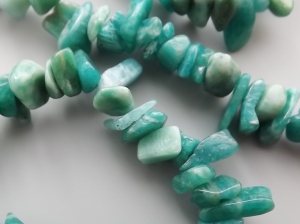What is amazonite?
Amazonite gemstone is a member of the feldspar family, a group of rock-forming minerals that make up over half of the Earth’s crust (other varieties of feldspar include labradorite, moonstone and sunstone). It’s glamorous name evokes visions of a beautiful tropical Amazon river expanse, yet strangely enough amazonite isn’t actually found near there at all (though it is found in other parts of Brazil), and the origins of its name have been lost in the midst of time.
Amazonite’s beautiful blue to blue green colours have made it a desirable decorative stone for thousands of years; amazonite jewellery and inlay work was discovered at Tutankhamen’s tomb, and amazonite decorative objects have been found at ancient Mesopotamian sites.
Family: feldpsar
Varieties: amazonite is a variety of feldspar and categorized as a microcline feldspar (it can sometimes also contain other feldspar minerals, such as orthoclase and albite).
Geology: found in igneous rock and metamorphic rock
Formation: amazonite forms deep inside the Earth. When hot, melted rock called magma cools down very slowly, it turns into a hard type of igneous rock called granite; this granite contains a number of minerals (which crystallize/ solidify to form the rock), of which quartz and feldspar make up the majority. When certain chemical reactions and conditions are produced, amazonite will form as the variety of feldspar.
Amazonite can also occur as a result of metamorphism, which is when an already formed rock now gets re-heated and pressured within the Earth (eg because of seismic activity), producing lots of changes and chemical reactions within it. The rock now becomes quite different in composition and appearance as to how it was originally was. Amazonite can occur when a rock (containing feldspar) is undergoing metamorphosis and it begins to chemically alter due to the intense metamorphism process; if the correct conditions and elements are present, the feldspar will turn into amazonite.
Colours: amazonite comes in various shades of light blue, green, turquoise, aqua blue and blue-green. It often has a stripey or subtle mottled pattern appearance. What actually causes amazonite’s colour is still being studied; so far it‘s believed to be caused by a complex chemical reaction between traces of lead, water and radiation (some research suggests that traces of iron may have some effect on the colour too).
Treatments: amazonite can be left natural, or sometimes it will undergo treatment if needed, such stabilizing it with resin to prevent it from crumbling, or dying it to enhance the colour.
Fakes: over the years some opaque pale blue gemstones sold as ‘amazonite’ has been tested and are actually a type of stabilized quartz. Some people have tried to sell amazonite as jade, but please note it is not a type of jade. The terms ‘Amazon Jade’ or ‘Colorado Jade’ or ‘Brazilian Jade’ are sometimes names used to describe amazonite, but these are incorrect descriptions/ misnomers and shouldn’t be used, as amazonite is not a type of jade. ‘Brazilian jade’ is an especially incorrect term for amazonite, as real genuine jade is found in Brazil, and the use of ‘Brazilian Jade’ for amazonite can cause immense confusion.
Locations: amazonite is found in many locations across the world, including the USA, Brazil, Russia, Namibia, India and parts of Scandinavia.
MOHS scale: 6 to 6.5
Chemical Composition: KAlSi3O8
Care: amazonite contains traces of lead so it should be handled with care; it should not be placed in water, nor swallowed, nor the water it was placed in swallowed. It should not be given to, nor worn around children (who might place it in their mouth).
Amazonite is quite a soft gemstone that can sometimes be prone to scratching and chipping. Excessive wear can also make it lose its shiny polish over time. As with many gemstones, some amazonite can fade if worn or kept in direct sunlight over a prolonged period of time, so when not being worn it should be store it in a dark place, separated from other gemstones so that it doesn’t get scratched.
As jewellery, amazonite is probably best worn in a protective setting (such as close back bezel) both because of its softness, and also so that it won’t come into contact with the skin. You can clean amazonite by gently washing it in tepid mild soapy water, rinse well and dry immediately with a soft cloth.
Cool stuff: there are some fascinating folk tales surrounding amazonite, including one that suggests that it was named after the legendary ancient Amazon warrior women. According to the myth, amazonite stones were used by Amazonian women as a talisman of courage and strength, and some say they would decorate their weapons with them.
Ancient Egyptians placed great value on amazonite, using it to make beautiful beads, amulets and seals, whilst in more modern times some people have worn amazonite in a belief that it might help them to develope a deeper connection with nature.
Though not an official birthstone, amazonite is increasingly being used as an unusual alternative to turquoise for December’s gemstone.

